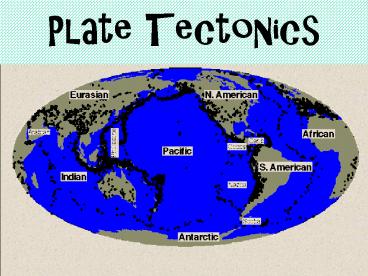Plate Tectonics - PowerPoint PPT Presentation
1 / 59
Title:
Plate Tectonics
Description:
Plate Tectonics Theory of Plate Tectonics Meaning plate structure Developed 1960 s Explains the movement of Earth s plates, causes of volcanoes ... – PowerPoint PPT presentation
Number of Views:90
Avg rating:3.0/5.0
Title: Plate Tectonics
1
Plate Tectonics
2
Theory of Plate Tectonics
- Meaning plate structure
- Developed 1960s
- Explains the movement of Earths plates, causes
of volcanoes, earthquakes, ocean trenches,
mountain formation, and other geological
phenomena.
3
Plate Tectonics Theory The Earths lithosphere
is divided into sections (plates) that move
(float) on the asthenosphere due to convection
currents in the mantle.
4
Earths Major Plates
5
Seven Major Plates Seven Minor Plates
African PlateAntarctic PlateEurasian PlateIndian-Australian PlateNorth American PlatePacific PlateSouth American Plate Arabian PlateCaribbean PlateCocos PlateJuan de Fuca PlateNazca PlatePhilippines PlateScotia Plate
6
- Plates move about 1-10 cm per year!!!
- Seismic activity (volcanoes and earthquakes)
occur as plate boundaries interact.
7
- http//www2.wwnorton.com/college/geo/egeo/animatio
ns/ch2.htm
8
Stress Tension Compression Shearing
9
Deformation
lthttp//www.unitedstreaming.com/gt
10
Earthquake
lthttp//www.unitedstreaming.com/gt
11
Anticline
lthttp//www.unitedstreaming.com/gt
12
Syncline
lthttp//www.unitedstreaming.com/gt
13
Normal Fault
http//www.tinynet.com/faults.html
14
Reverse Fault
http//www.tinynet.com/faults.html
15
Strike-slip Fault
http//www.tinynet.com/faults.html
16
Ring of Fire
17
Plate Boundaries
- There are 3 types of plate boundaries
- Divergent
- Convergent
- Transform
18
Divergent movement of 2 plates away from each
other (tension)
19
Quiet (non catastrophic) eruptions
lthttp//www.unitedstreaming.com/gt
20
Types of lava
aa lava
lthttp//www.unitedstreaming.com/gt
21
pahoehoe lava
lthttp//www.unitedstreaming.com/gt
22
mid ocean ridge fissure
lthttp//www.unitedstreaming.com/gt
23
Shield Volcano
lthttp//www.unitedstreaming.com/gt
24
Mid-ocean ridge
lthttp//www.unitedstreaming.com/gt
25
Surtsey
lthttp//www.unitedstreaming.com/gt
26
Stages in basin history are Embryonic - rift
valley forms as continent begins to
split. Juvenile (young) - sea floor basalts begin
forming as continental sections diverge. Mature -
broad ocean basin widens, trenches develop and
subduction begins. Declining - subduction
eliminates much of sea floor and oceanic
ridge. Terminal - last of the sea floor is
eliminated and continents collide forming a
continental mountain chain. Geosuture (relic
scar) folded mountains with evidence of former
ocean basin.
27
New crust forming in axial trough via sea-floor
spreading
28
Basalt injections in narrow trough resulting is
separation from Africa
29
3-3
Because Earths size is constant, expansion of
the crust in one area requires destruction of the
crust elsewhere.
- Currently, the Pacific Ocean basin is shrinking
as other ocean basins expand. - Destruction of sea floor occurs in subduction
zones.
30
(No Transcript)
31
- Major Ocean Basins
- Pacific Ocean
- largest (180,000,000 km2) and deepest (averaging
3,940 m) basin - extensive marginal seas and volcanic island
systems and trenches - considerable mountain building and earthquake
activity along boundaries - little freshwater input
- Atlantic Ocean
- second largest basin (107,000,000 km2)
- average depth 3,310 m
- large freshwater input (Amazon, Congo,
Mississippi, Niger, Orinoco Rivers) - small number of marginal seas (Gulf of Mexico,
Caribbean, Mediterranean) - Indian Ocean
- smallest basin (74,000,000 km2)
- average depth 3,840 m
- large sediment input (Indus and Ganges River
deltas) - small number of marginal seas (Arabian Sea,
Persian Gulf, and Red Sea)
32
- Chronology of Modern Ocean Basin Development
- 200 million years ago
- formation of the supercontinent Pangaea
- presence of the Panthalassan 'super ocean'
- Atlantic and Indian Oceans not present
- 180 million years ago
- initial break up of Pangaea and formation of
Laurasia and Gondwanaland - presence of an east-west trending basin (the
Tethys Sea) - 140 million years ago
- separation of Eurasian and North American plates
- onset of mid-Atlantic ridge development
- early formation of the North Atlantic
- South Atlantic still closed
- 80 million years ago
- separation of the African and South American
plates - early formation of the South Atlantic
- 60 million years ago
- Indian plate reaches equator after separation
from Australia and Antarctica - North and South Atlantic continue to widen 40
million years ago
33
Hot SpotsHawaii Mauna Loa (shield volcano)
lthttp//www.unitedstreaming.com/gt
34
(No Transcript)
35
(No Transcript)
36
Kilauea Eruptions
37
Yellowstone
lthttp//www.unitedstreaming.com/gt
38
Transform plates sliding horizontally past each
other.
39
San Andreas fault 100 miles north of L.A
40
(No Transcript)
41
(No Transcript)
42
(No Transcript)
43
Convergent colliding of 2 plates
44
Convergent collision continental plate vs.
continental plate - forms folded mountains -
shallow earthquakes
45
Convergent subduction ocean plate vs.
continental plate - forms trenches, volcanic
mountains - deep earthquakes
46
How does the ocean floor keep getting wider
- The ocean floor plunges into deep under water
trenches. - A deep ocean trench forms where the oceanic crust
collides with continental crust. - Subduction is the process by which the ocean
floor sinks beneath a deep-ocean trench and back
into the mantle.
47
Convergent subduction ocean plate vs. ocean
plate - forms trenches, volcanic island arc -
deep earthquakes
48
FYI
- Most ocean trenches are found in the Pacific
Ocean. - The deepest part of the ocean is the Mariannas
Deep. It is located in the Pacific Ocean - The Pacific Ocean is shrinking, but it is still
the Largest ocean
49
Vulcanean eruption
http//www.nationalgeographic.com/forcesofnature
50
Paricutincinder cone volcano
http//www.nationalgeographic.com/forcesofnature
http//www.nationalgeographic.com/forcesofnature
51
Mt. St. Helenscomposite cone volcano
http//www.nationalgeographic.com/forcesofnature
52
Mt. Mazama
http//www.nationalgeographic.com/forcesofnature
53
Mt. Tambora Indonesiathe year without a summer
http//www.nationalgeographic.com/forcesofnature
54
Vesuvian eruption
http//www.nationalgeographic.com/forcesofnature
55
Vesuvius Pompei
http//www.nationalgeographic.com/forcesofnature
http//www.nationalgeographic.com/forcesofnature
56
Strombolian eruption
http//www.nationalgeographic.com/forcesofnature
57
Krakatoa
http//www.nationalgeographic.com/forcesofnature
58
Peléan eruptionNueés Ardente - a super hot
cloud of ash and gas that flows very fast like a
liquid.
59
Mt. Pelee
http//www.nationalgeographic.com/forcesofnature
http//www.nationalgeographic.com/forcesofnature































